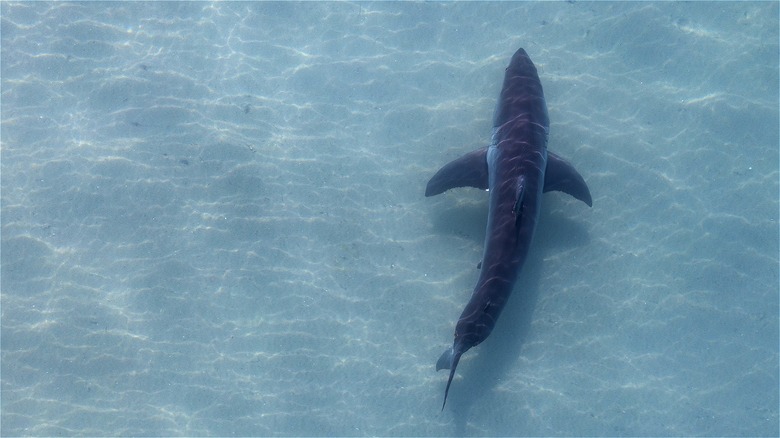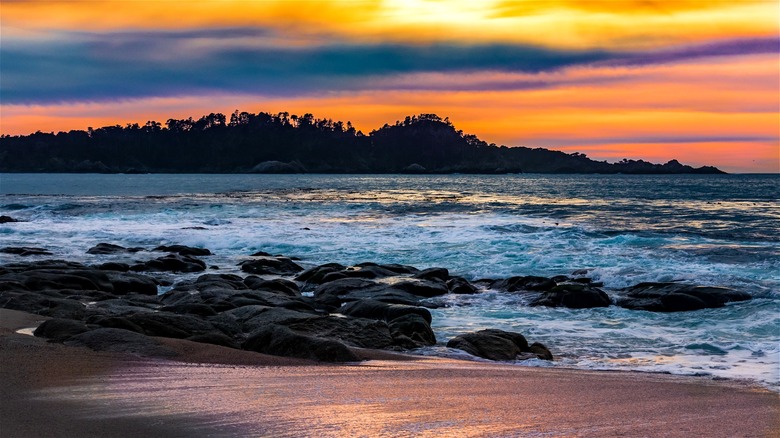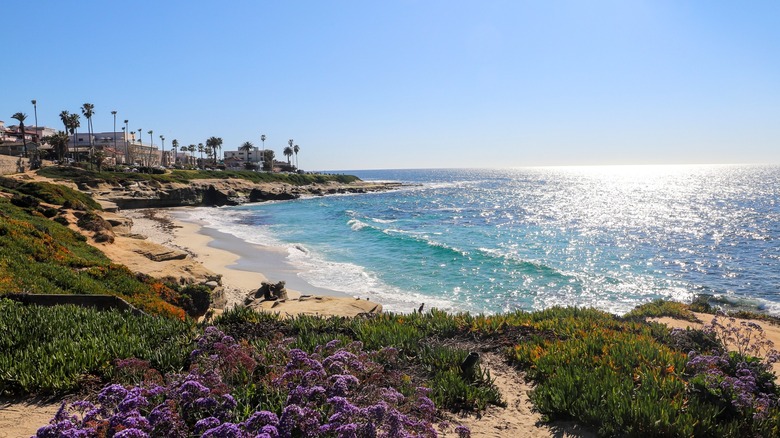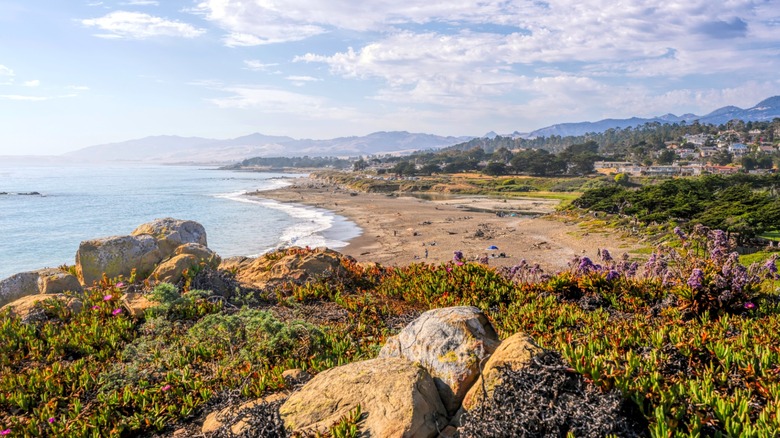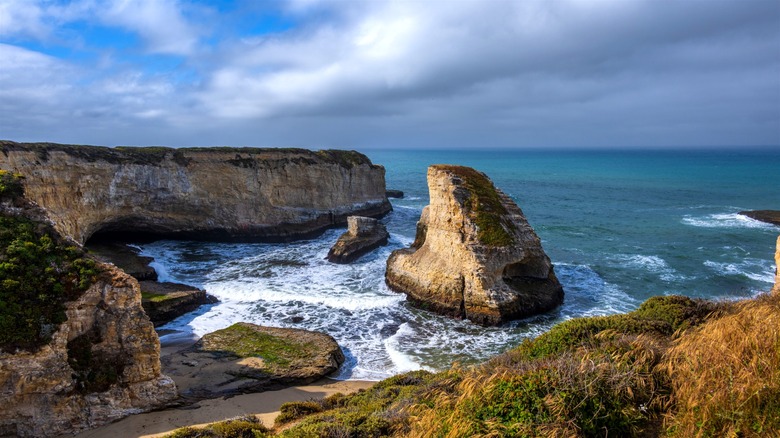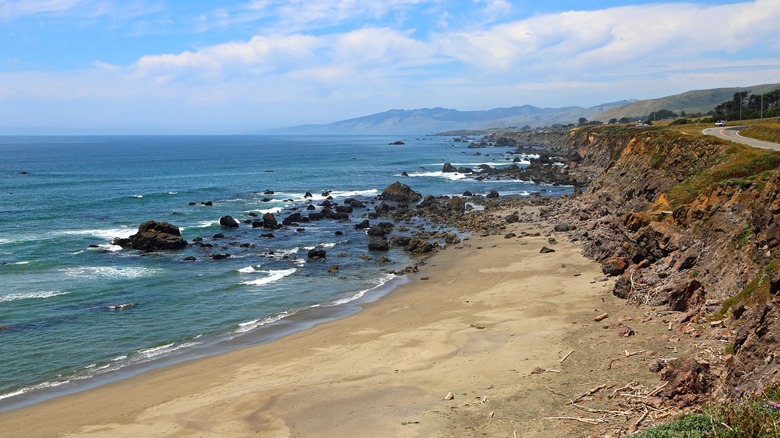These 5 Beaches Have Had The Most Shark Attacks In All Of California
Some may push back against shark stigma by claiming that great whites and other species are not dangerous animals. This is not true. Any predatory animal that has rows of razor sharp teeth, an intense prey drive, and weighs over 4,000 pounds is seriously dangerous. That doesn't mean you should be overly worried about sharks, though. The truth is that we simply aren't that appetizing. To a shark, the human being is a skinny, bony mammal — a gristly piece of mutton compared to the filet mignon of fur seals and other preferred prey.
Still, sharks remain a dangerous, fatal threat. In 2005, National Geographic said the United States averaged 16 shark attacks per year, and almost one related fatality every two years. By 2023, global shark attack numbers had increased, with the Global Shark Attack File reporting 111 attacks in 2015, the highest on record. As reported by Time, population increase puts these figures into perspective. While there's been an overall increase in unprovoked shark attacks per 1 billion people since the 1970s, the rate of such attacks per billion people was lower at the end of the 1950s — 16.83 — than 2022's 10.16.
In any case, sharks pose a very minor threat to humans. You can't call the rare few that bite malicious, either, for most of them are driven by curiosity rather than a thirst for flesh. However, there are shark-infested beaches in several areas of the world where you should exercise vigilance, and some of them are in California. Here are the five beaches with the most recorded attacks in the state.
Monastery Beach, three attacks
Since 1950, there have been three shark attacks at Monastery Beach, a steep cove just south of Carmel-By-The-Sea. It's a great place to escape the California crowds, but its treacherous landscape has earned it the moniker "Mortuary Beach" — and the danger doesn't end there. The first shark attack occurred at 8:00 a.m. on September 25, 1982, when 36-year-old Bruce Lang was scuba diving in 40 feet of water. A great white attacked him, lacerating his hand.
The second, more serious attack happened four years later on December 6, 1986. A great white shark attacked freediver Frank Gallo in 38 feet of water, puncturing his right lung and slashing his neck, shoulder, jaw, and forearm. Surgeons worked for four hours on these major injuries, and the 27-year-old man pulled through.
The third attack came another four years later on November 3, 1990. At around 3:00 p.m., a great white shark bit scuba diver Eloise Tavares on the leg as she paddled on the surface. She survived the frightening ordeal.
La Jolla, five attacks
La Jolla beach is located just north of San Diego, California's oldest city. A great white shark first struck its waters on June 14, 1959, killing 33-year-old freediver Robert Pamperin. His companion, Gerald Lehrer, said he witnessed the shark swallow his friend. "[It was] so big it looked like a killer whale," Lehrer told the San Diego Union. Weeks later, on July 28, a hammerhead shark bit 25-year-old Vernon S. Fleet on the upper-left thigh. His injury was not fatal.
Decades passed without a shark attack until June 24, 1995, when a great white shark attacked a 19-year-old woman kayaking off La Jolla beach. The fish knocked the woman into the water, but she managed to reach the shore alive, albeit with a shark's tooth in her face. Ten years later, a juvenile great white attacked 37-year-old surfer Tony Simmonson. "As soon as my foot touched bottom a shark bit me on my lower right leg, on the inside side near my ankle," Simmonson said, per the Shark Research Committee. "The shark was about four feet in length and dark gray with a stocky body," he later added.
The fifth and most recent shark attack at La Jolla occurred on June 6, 2011. Justin Schlaefli spotted what he believed to be a sevengill shark taking an interest in him and his friends. "Something in the body language of the shark screamed 'danger' at me," Schlaefli wrote on an online spearfishing forum. Moments later, the sevengill had Schlaefli's calf in its mouth, biting down three times. Fortunately, Schlaefli and his friends reached the shore unscathed.
Moonstone Beach, five attacks
On October 18, 1976, a great white shark attacked surfer Bill Kennedy off Moonstone Beach in Humboldt County. Like most of the country, the 25-year-old had seen "Jaws" the previous year, and John Williams' haunting score played in his head as he surfed the waves at his favorite beach. The shark grabbed onto Kennedy from behind, but his leg slipped out of its mouth, allowing him to catch a wave back to shore. He needed 35 stitches.
A second attack occurred four years later on October 17, 1980, but no injuries were reported. Seventeen years later, on August 24, 1997, Scott Yerby was not so lucky. The 29-year-old man was surfing when a great white shark bit his leg and launched him off his board. "I could see my femur, there was blood in the water — I knew then it was pretty serious," Yerby told Time. He struck the shark on its nose and broke free from its jaws. By the time he got to hospital, he had lost almost 5 pints of blood — around half the average amount in the human body.
There was another close encounter on September 21, 2002, when a morning surfer escaped a great white attack with no injuries, and again five years later on the afternoon of September 27, 2007. As of 2024, no attacks have happened at Moonstone Beach since.
Davenport, six attacks
Davenport is a census-designated place a short distance from Santa Cruz, home of the serene Natural Bridges State Beach. Recorded shark attacks began in its beaches on October 26, 1987, when a great white attacked 20-year-old surfer Conrad Brown, biting his leg and buttock. The second happened on July 1, 1991 — another great white bit Eric Larsen's leg and pulled him underwater.
The surfer managed to open the shark's jaws and swim away, but the fish bit down on his arm. Larsen punched the determined fish until it released him, and he swam back to shore with terrible wounds including a severed artery. His first-aid training saved his life and got him to the emergency room, where he had 10 hours of reconstructive surgery to sew over 2 feet of wounds with 400 stitches and metal staples. Three months later, on October 5, 32-year-old John Ferrara was bitten twice by a great white — quite possibly the same one that attacked Larsen. Ferrara was airlifted to hospital with major gashes to his arm and back.
Three minor attacks have happened since the near-death events in 1991. On September 28, 1995, 25-year-old windsurfer Mike Sullivan received a bitten board and a bruised foot courtesy of a great white shark. Years later, on November 5, 2009, professional surfer Eric Geiselman claimed a great white smashed his board in half. Most recently, on October 7, 2012, a great white shark knocked Gunnar Proppe off his board, breaking it. He got to shore with a bleeding toe.
Salmon Creek Beach, nine attacks
Located in the underrated Sonoma Coast State Park, Salmon Creek Beach is one of the state's top shark attack hotspots. On August 20, 1961, 16-year-old David Vogensen was swimming in its waters when a 13-foot great white approached him head-on and bit his groin and thighs. Fortunately, the shark released him and vanished, allowing Vogensen to return to shore, where he collapsed. Doctors performed hours of surgery on flesh, tendon, and nerve injuries and expected the teenager to make a full recovery.
Some 35 years passed before Salmon Creek Beach experienced another attack on October 3, 1996. A 5-meter great white attacked surfer Kennon Cahill, but the 31-year-old managed to escape unscathed. Another non-fatal attack occurred the following month on November 29, 1996.
On November 28, 2002, almost exactly six years since the last attack, a 16-foot great white shark attacked bodyboarder Michael J. Casey, launching him in the air and tearing deep cuts into his legs. Casey survived the ordeal. Another incident happened on May 28, 2004, leaving Bernard Connor Jr. with a bite from a 14-to-18-foot great white. Two further major attacks occurred on October 19, 2005, and October 3, 2021, inflicting severe leg injuries to Megan Halavais and Eric Steinly, respectively. More attacks on May 7, 2019 and December 22, 2021, transpired without injury.
